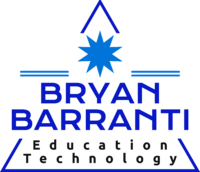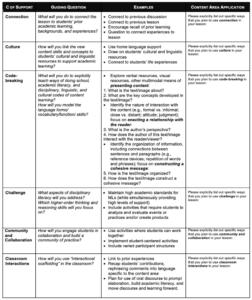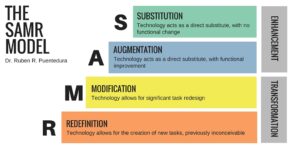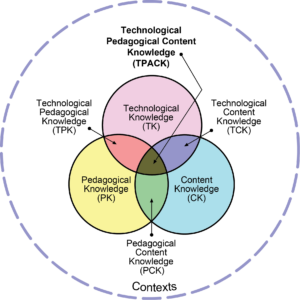Every time I sit down to reflect on the work I’ve done with this project, I feel like I’m revisiting a living document, one that has grown and evolved alongside my teaching practice. The process hasn’t always been smooth, and there have been plenty of moments where I’ve felt stuck or questioned the direction I was taking. I’ve spent many full days and late nights working on this, especially during Christmas break and one or two sick days per week in December and January. The physical curse of dealing with major back issues became, in an unexpected way, a blessing in gained time to focus deeply on this work as sitting was the only comfortable position I had. But through the ups and downs, I can confidently say that this project has been a meaningful journey. Here’s a breakdown of the major changes, the strengths I’ve leaned on, and the challenges I’ve navigated.
Major Changes and Omissions
- LACI’s Six Cs of Support
The Language-Based Approach to Content Instruction (LACI), developed by de Oliveira et al. (2021), offers a comprehensive framework for scaffolding English Language Learners through its Six Cs of Support: Connection, Culture, Code-breaking, Challenge, Community and Collaboration, and Classroom Interactions. Each of these elements fosters meaningful engagement by connecting students’ experiences to academic content. What makes this approach so effective is that each element is driven by guiding questions:
- Connection: What will you do to connect the lesson to students’ prior academic learning, backgrounds, and experiences?
- Culture: How will you link the new content skills and concepts to students’ cultural and linguistic resources?
- Code-breaking: What will you do to explicitly teach ways of doing school, academic literacy, and content-specific skills?
- Challenge: What aspects of disciplinary literacy and higher-order thinking will you address?
- Community and Collaboration: How will you engage students in collaboration and build a community of practice?
- Classroom Interactions: How will you use interactional scaffolding in the classroom?
One of the most significant additions to my project has been creating my version of LACI’s Six Cs of Support tailored to woodwork projects and English Language Learners. I realized early on that this framework needed to be more than a checklist for me; it had to be embedded within hands-on learning experiences. For example, during the laser-engraved box project, students researched culturally meaningful animal symbols, learning about First Peoples’ beliefs and how to represent these through engravings. For English Language Learner students, this wasn’t just an art or technical project, it was an exercise in connecting with cultural narratives (Culture) by linking their designs to meaningful symbols and stories. They also engaged in collaboration (Community and Collaboration) by gathering feedback, brainstorming ideas, and refining their work together.
Beyond collaboration, the project also provided meaningful Connection by linking prior academic learning about cultural symbols with hands-on application in design. Students had opportunities for Code-breaking as they learned to decode instructions, understand design software, and grasp technical vocabulary related to laser engraving. The project also emphasized Challenge, as students had to push beyond basic design skills and engage in critical thinking to ensure their engravings effectively conveyed cultural significance. Finally, Classroom Interactions were fostered through structured peer discussions, teacher-led critiques, and interactive demonstrations that provided the scaffolding necessary to complete their designs effectively.
By incorporating all six Cs, this project became more than just a woodworking task, it became an opportunity for deeper engagement, critical thinking, and meaningful learning for all students, particularly English Language Learners.
- Google Classroom Structures
Setting up the main structures for my Google Classroom has been another important refinement. This wasn’t just about organizing assignments; it was about creating a digital space where Technology-Integrated Learning could seamlessly support Universal Designs for Learning practices. My Google Classroom is structured with sections that cater to differentiated learning, like visual handouts and step-by-step guides for project-based tasks.
One of the biggest successes here was designing digital quizzes for safety tests and integrating formative assessments that let students reflect on their own learning. This structure also includes accessible resources for English Language Learners students, such as translated instructions and visual aids, which address English Language Learners Educational Challenges directly.
The challenge here was balancing simplicity and functionality. I didn’t want the platform to overwhelm students or become a dumping ground for content. After several iterations, I found a balance where students could easily navigate the materials while still being challenged. I believe that the layout of my Google Classroom is thoughtfully designed to provide intuitive, easy-to-navigate access to course materials and updates.
- Omission of Constructivism
This was a difficult decision. Constructivism is foundational to my teaching as it is how I view learning as an active, hands-on process. But as the project evolved, I realized that Constructivism didn’t need to take up valuable space in my writing. Its principles are embedded throughout my practices, from students building meaning through projects to the reflective assessments I use. While I didn’t formally include Constructivism in the paper, its presence is felt in the examples and teaching strategies I describe.
- Omission of SAMR
I initially planned to discuss SAMR (Substitution, Augmentation, Modification, Redefinition) in-depth, but as I refined the scope, I realized it didn’t align as well as I thought. SAMR is part of how I view Technology-Integrated Learning, but my project focuses more on practical applications of Universal Designs for Learning and the integration of tools that directly support English Language Learners. While SAMR remains part of my daily practice, I chose to focus on the frameworks that have a clearer connection to my paper’s purpose. In particular, TPACK (Technological Pedagogical Content Knowledge) aligned better with the project’s goals by emphasizing the intersection of content knowledge, pedagogy, and EdTech. Unlike SAMR , which primarily categorizes technology use, TPACK provides a framework to integrate EdTech tools, such as Google Classroom, Computer Aided Design software, and laser machines, in ways that support both English Language Learners and woodwork projects through thoughtful planning and practice.
Strengths: Where I’ve Thrived
- Adaptability
One of my biggest strengths has been my ability to adapt as new challenges and ideas come up. When I realized that LACI’s Six Cs could be adapted specifically for woodwork and English Language Learner students, I didn’t hesitate to explore that path, even if it meant reshuffling parts of my project. I’ve also adapted based on feedback from Michael and from my peers, refining the Google Classroom structures and ensuring that key ideas like Universal Designs for Learning remain front and center.
- Connecting Theory to Practice
I’ve been able to take theoretical ideas and make them work in a practical woodworking classroom setting. Whether it’s integrating visual aids for English Language Learner students or creating scaffolded assignments through Google Classroom, I’ve kept the focus on how theory can enhance student learning. I think this is where my background in woodwork really shines, as I’m used to problem-solving and iterating until I get it right.
- Embracing Diversity
My commitment to creating an inclusive learning environment for all students, especially English Language Learners, is another strength. I’ve incorporated First Peoples’ Principles of Learning into my projects and designed activities that honour students’ diverse backgrounds. This has allowed me to create meaningful learning experiences that go beyond technical skills.
Challenges: Where I’ve Struggled and Survived
- Balancing Breadth and Depth
One of the biggest challenges has been deciding what to include and what to leave out. Omitting Constructivism and SAMR wasn’t easy, and I still second-guess those choices. There’s a part of me that worries about whether I’ve left out something critical. But at the same time, I know that focusing on fewer frameworks has allowed me to go deeper into how Universal Designs for Learning, scaffolding, and Technology-Integrated Learning support English Language Learners.
- Time Management and Writing Structure
Between teaching, family commitments, and this project, time has been a challenge. There were moments when I felt overwhelmed, especially when I had to revise large sections or rethink my Google Classroom structures. However, having all that extra time off with one or two sick days per week gave me unexpected opportunities to work on revisions and improvements. I created a good system by first reading journals and creating citations of key quotes along with my personal reflections. I then organized different Google Docs for each main topic to store all relevant quotes. From there, I selected an array of quotes for each topic and copied them into my main Word document. Finally, I worked around these quotes to create my full writings. This structured process has been invaluable, serving as both a time management and organizational tool for my writing. I’ve learned to lean on my organizational skills and accept that not everything will be perfect the first time around.
- Navigating New Technologies
Although I’m comfortable with most of the tools I use, there were times when integrating new tech, like Google Classroom and digital assessments, felt overwhelming. I had to troubleshoot issues and ensure that everything was accessible to students, especially those facing English Language Learners Educational Challenges. I also faced frustrations with Microsoft Word while writing this paper, from formatting glitches to version control issues between desktop and 360. Despite these setbacks, in the end, these struggles have made me more confident in my ability to problem-solve and adapt to my technologies.
Final Thoughts
Reflecting on this journey, I’m proud of how much I’ve grown as a teacher and a learner. The major changes, such as the deliberate omissions of Constructivism and SAMR and the refinement of my Google Classroom, have strengthened my writing and focus within the paper. The process of carefully deciding what to include and what to leave out was challenging, but it enabled me to focus more deeply on the frameworks that mattered most. The challenges I’ve faced, particularly in refining my Google Classroom to provide intuitive and effective access to materials, have been valuable learning experiences, reminding me that writing is as much about the process as the outcome.
As I move forward, and with a major part of my writing completed, I know this project will continue to evolve. There will always be new challenges and opportunities to refine my writing, but I’m eager to see how this journey will shape not only my future projects but also my teaching practice.
References:
de Oliveira, L., Braxton, D., & Gui, J. (2021). Planning for Instruction using a Language-Based Approach to Content Instruction for Multilingual Learners. Journal of English Learner Education, 13(1). https://stars.library.ucf.edu/jele/vol13/iss1/2




